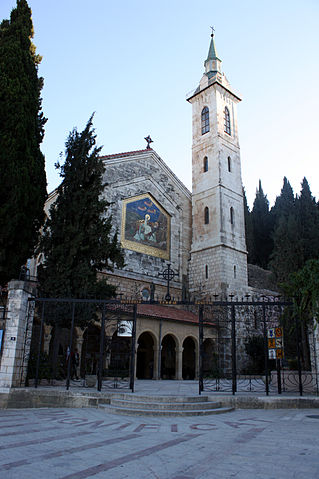Church of the Visitation


The Church of the Visitation in Ein Karem, Jerusalem, honors the visit paid by the Virgin Mary, the mother of Jesus, to Elizabeth, the mother of John the Baptist. (Luke 1:39–56) This is the site where tradition tells us that Mary recited her song of praise, the Magnificat, one of the most ancient Marian hymns.
History
One tradition attributes the construction of the first church of Ein Karem to Empress Helena of Constantinople, Constantine I’s mother, who identified the site as the home of John’s father, Zachary and the place where Elizabeth and her infant son hid from Herod’s soldiers. Possibly due to the Muslim takeover of Jerusalem in 638, the original shrine must have gone out of reach for Christian pilgrims and by the time the Crusaders conquered the Holy Land, they found in Ein Karem two different locations venerated in connection with the main points of interest for pilgrims: the meeting between Mary and her cousin Elizabeth, the home of Zachary and Elizabeth, the birth of John, and the hiding place of Elizabeth and John. They erected two main churches here, the precursors of what are today the Church of St John the Baptist and the Church of the Visitation. After the departure of the Crusaders, the different traditions shifted back and forth between the two locations.
At the site of the Church of the Visitation the Crusaders erected a two-story church dedicated to the meeting between Elizabeth and Mary over the ancient ruins they found here. When the Crusaders were pushed out of the Holy Land, the church gradually deteriorated. In the 14th century it was for a while under the care of Armenian monks, but in 1480 a pilgrim reports only ruins from the site. The Franciscans bought the property from an Arab family in 1679, excavated the grounds in 1937 and erected a new church in the following years, preserving all extant Byzantine and Crusader remains as part of the new shrine.
Archaeologists found a Byzantine cistern in the courtyard and, more significantly, the remains of a Byzantine chapel over which the later churches were erected.
Description
The courtyard contains a statue of Mary and Elizabeth, and on the wall opposite the entrance to the lower church are forty-two ceramic tablets bearing the verses of the Magnificat in as many different languages. On the facade of the upper church is a striking mosaic commemorating the Visitation. Next to the church proper, a Crusader hall of the 12th century survived in good condition.
The lower church contains a narrow medieval barrel-vaulted crypt ending with a well-head from which, according to tradition, Elizabeth and her infant drank. The well is connected to a Roman or Byzantine overflow pipe running under the medieval floor. The rock with a cleft next to the entrance of the medieval crypt is said to mark the site where the mountain opened up to hide Elizabeth and the infant John from Herod’s soldiers – this is the “Rock of Concealment”. This tradition is based on the 2nd-century apocryphal Protoevangelium of James 22:3. The interior of the lower church holds Italianate frescoes depicting Archangel Gabriel announcing to Zachary, who is shown next to the altar of the Jewish Temple, that he will have a son; the Visitation; and Elizabeth hiding her son during the Massacre of the Innocents in nearby Bethlehem. Also preserved are remains of the ancient church and beautiful mosaic floors.
The upper church is dedicated to Mary, and its walls are decorated with paintings depicting crucial episodes from the evolution of Mariology, such as The Wedding of Cana, which consecrated Mary as the Mediatrix, the prime intercessor between men and Jesus; the Council of Ephesus (431) during which she was defined as Theotokos or the Mother of God; the Battle of Lepanto (1571) in which a united Christian fleet defeated the Ottoman fleet, a victory ascribed to the help of the Virgin Mary and celebrated by the Catholic Church with the feast of Our Lady of the Rosary; and so forth. Verses from the Magnificat are painted on the columns of the church.
Source : Wikipedia
https://www.youtube.com/watch?v=wrvqWNbpGug
https://www.youtube.com/watch?v=UTWjMs97mpw
Reviews
https://goo.gl/DFxaPM


Rate this article